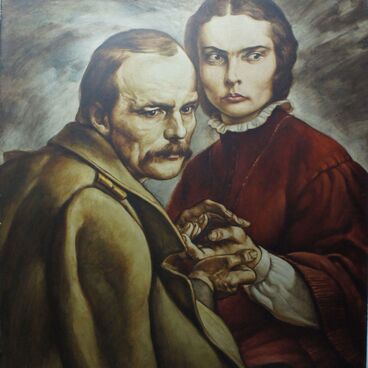Kuznetsk got its first city seal in the 1630’s. It was made of silver, was about 3 cm large in diameter and 2 mm thick, like a regular coin.
Every big city had a seal like this. In the past, they were viewed as symbols of government. To make an impression, the seal would be pressed to hot wax, which then took the shape of the chiselled pattern or symbol or any other image. This was the procedure that was usually employed to seal bags with goods sent to other cities, or laissez-passers, or other important documents, including letters to high-standing officials. Seals for Siberian fortresses and cities were manufactured by the Kazan Palace Prikaz (i.e. department), later the Siberian Prikaz, in Moscow.
The 1656 List of Siberian city seals with a description of their coats of arms says that the Kuznetsk seal shows a wolf indicating “a poorly populated land”. The genuine city seal has not survived, but scholars have succeeded in finding its 1694 impression in the 1858 Collection of prints from ancient seals attached to legal acts and other instruments held by the Moscow Archive of Ministry of Justice by Pyotr Ivanov.
However, to some explorers the animal chiselled on the seal seemed more like a horse rather than a wolf. So they suspected that Kuznetsk city seals came to include an image of a horse towards the end of the 17th century, though the official coat of arms bearing this image was not granted to the city by Emperor Alexander I until the early 19th century.
The replica displayed by the Museum was made after the print from Ivanov’s Collection of prints and reproduces the ancient city seal in detail.
Every big city had a seal like this. In the past, they were viewed as symbols of government. To make an impression, the seal would be pressed to hot wax, which then took the shape of the chiselled pattern or symbol or any other image. This was the procedure that was usually employed to seal bags with goods sent to other cities, or laissez-passers, or other important documents, including letters to high-standing officials. Seals for Siberian fortresses and cities were manufactured by the Kazan Palace Prikaz (i.e. department), later the Siberian Prikaz, in Moscow.
The 1656 List of Siberian city seals with a description of their coats of arms says that the Kuznetsk seal shows a wolf indicating “a poorly populated land”. The genuine city seal has not survived, but scholars have succeeded in finding its 1694 impression in the 1858 Collection of prints from ancient seals attached to legal acts and other instruments held by the Moscow Archive of Ministry of Justice by Pyotr Ivanov.
However, to some explorers the animal chiselled on the seal seemed more like a horse rather than a wolf. So they suspected that Kuznetsk city seals came to include an image of a horse towards the end of the 17th century, though the official coat of arms bearing this image was not granted to the city by Emperor Alexander I until the early 19th century.
The replica displayed by the Museum was made after the print from Ivanov’s Collection of prints and reproduces the ancient city seal in detail.

